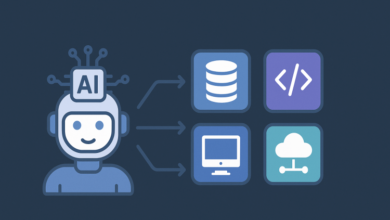Agent-Based Computing Is Evolving Beyond the Web

▼ Summary
– The internet is undergoing a fundamental redesign to accommodate AI agents, shifting from human-centric interfaces to machine-native design.
– AI agents will transition from passive assistants to active participants, making decisions and transactions autonomously on behalf of users.
– The future web for AI will prioritize speed, structured data, and verifiable sources, with APIs replacing traditional storefronts.
– Brands must optimize for AI compatibility, focusing on machine readability, efficiency, and trust to remain competitive.
– The internet will likely evolve into layered or parallel systems, with human-focused and machine-focused webs coexisting or integrating.
The digital landscape is undergoing its most radical transformation since the birth of the web. What began as a human-centric platform for browsing and interaction is rapidly evolving into an ecosystem where artificial intelligence operates as an equal participant rather than just a tool. This shift demands nothing short of a complete architectural overhaul, one that prioritizes machine efficiency over human aesthetics.
For decades, the internet has catered to our biological limitations: interfaces designed for eyes, navigation optimized for fingers, and decision trees disguised as websites. But AI agents, powered by systems like ChatGPT, Copilot, and Gemini, are no longer passive assistants. They’re transitioning into autonomous entities capable of making decisions, executing transactions, and managing tasks without human oversight. The problem? Today’s web forces these advanced systems to navigate a digital world built for flesh-and-blood users.
Imagine requiring a self-driving car to operate using reins and a saddle. That’s essentially what we’re doing with AI. Current interfaces demand artificial intelligence to mimic human actions, clicking buttons, filling forms, parsing visual layouts, when what it truly needs is direct access to structured data, instant decision-making protocols, and verifiable sources. The future web won’t just serve machines; it will speak their language.
Designing for Machines, Not Just Humans
Consider commerce: An AI doesn’t need to scroll through product carousels or read marketing copy. It requires instant answers to questions like, “Is this the best option for my user’s budget and preferences?” Brands that optimize for machine readability, not just human appeal, will dominate, because AI agents will favor efficiency, transparency, and structured data over aesthetic flourishes.
The Rise of Parallel Webs
In this new paradigm, the most successful businesses will treat AI compatibility like mobile optimization, a necessity, not an afterthought. Within years, AI agents won’t just assist with purchases; they’ll handle scheduling, negotiations, and decision-making across every facet of digital life. And they’ll bypass pretty interfaces in favor of the fastest, most trustworthy, and machine-friendly options.
Rewriting the Rules of Engagement
Just as roads evolved from horse trails to highways, the web will adapt to its new primary users. The next wave of innovation won’t unfold in browser tabs but in milliseconds, as machines execute transactions on a web designed, and possibly even governed, by their own logic. The question isn’t whether this future arrives, but who will be ready when it does.
(Source: VentureBeat)




